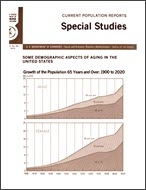Some Demographic Aspects of Aging in the United States
Some Demographic Aspects of Aging in the United States
Aging in the general sense of "getting older" is a phenomenon that affects all of us from the day we are born until the day we die, so that a discussion of the demographic aspects of aging could be concerned with how population characteristics vary with age. The present treatment of the subject does deal with such age variation to some extent but it focuses on the demographic characteristics of older people, namely those over 55, particularly those over 65 and over 75, where the impact of aging is most pronounced and of principal public concern. Since the older population is not a single homogeneous mass and their characteristics tend to vary sharply by age, even within the band 65 and over, it is desirable and even necessary to consider the older population in terms of component age groups, distinguishing at least an older and younger segment. For convenience and simplicity in the discussion, however, the single broad group 65 and over is often selected for detailed consideration.
A distinction should be made between the aging of individuals and the aging of populations. The demographer is interested in both aspects of aging. His interest in the former is limited to the general experience of population groups with respect to the aging of individuals; this experience is reflected in measures such as life expectancy and the probability of survival from one age to another. Aging of this kind is a function of changes in mortality rates. The aging of a population refers to the fact that a population is “getting older” and may be measured variously in terms of the median age, the proportion of persons 65 and over, the ratio of persons 65 and over to children under 15, etc. The various measures of aging may possibly indicate different degrees of aging and a population may be described as "aging" and “younging” at the same time if the proportion of aged persons and the proportion of children are both increasing.1 Aging of populations is a function of changes in mortality, fertility, and migration (see below).
__________
Note: Revised version of a background paper prepared for the Conference on "The Epidemiology of Aging" sponsored by the National Institute of Child Health and Human Development, U. S. Public Health Service, held at Elkridge, Md., June 11-14, 1972.
1 U.S. Bureau of the Census, The Methods and Materials of Demography, by Henry S. Shryock, Jacob S. Siegel, and Associates, U. S. Government Printing Office, Washington, D.C., 1971, pp. 234-235.
A Note on Language
Census statistics date back to 1790 and reflect the growth and change of the United States. Past census reports contain some terms that today’s readers may consider obsolete and inappropriate. As part of our goal to be open and transparent with the public, we are improving access to all Census Bureau original publications and statistics, which serve as a guide to the nation's history.
Others in Series
Publication
Publication
Publication




